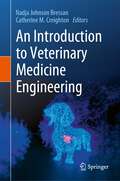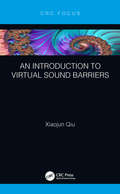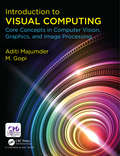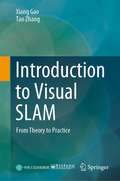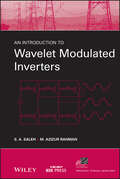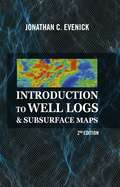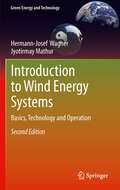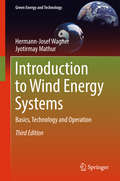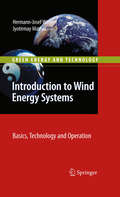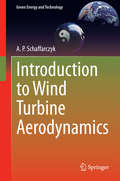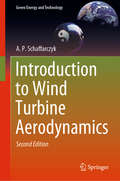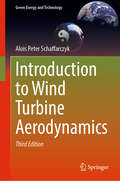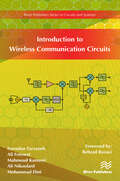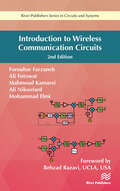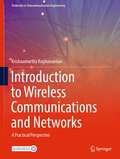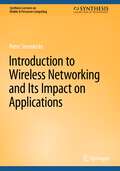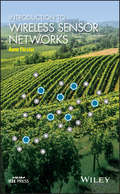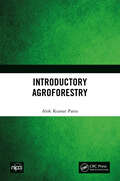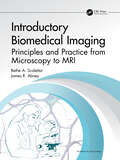- Table View
- List View
Introduction to Urban Water Distribution: Unesco-IHE Lecture Note Series (Ihe Delft Lecture Note Ser.)
by Nemanja TrifunovicFocusing primarily on understanding the steady-state hydraulics that form the basis of hydraulic design and computer modelling applied in water distribution, Introduction to Urban Water Distribution elaborates the general principles and practices of water distribution in a straightforward way. The workshop problems and design exercise develop a tem
An Introduction To Usability
by Patrick W. JordanThis work gives a broad introductory overview of the topic of usability. Firstly, usability is defined and a framework for identifying different aspects of usability is given. The main principles for creating usable designs are expounded, followed by practical advice as to how to design usable products. The book then tackles the issue of usability evaluation - a series of evaluation methods are described, followed by practical advice as to how to conduct the evaluation. The book draws on examples from software design and product design generally. This means whilst human-computer interaction HCI is a central issue in the book, other usability issues are also covered.
An Introduction to Veterinary Medicine Engineering
by Nadja Johnson Bressan Catherine M. CreightonDo cephalopods change color when under distress? Is the reptilian heart analogous to a diaphragm positive displacement pump? Are digital twins the answer for animal experimentation? This book explores the new field of veterinary engineering science and discusses how to better measure vital signs in exotic and companion animals. A vast opportunity exists for developing novel technologies that target reductions to the number of invasive procedures patients are subjected to. We examine improvements to animal care and enhancement of animal welfare while creating a more sustainable veterinary healthcare ecosystem. The authors address the challenges engineers face in designing healthcare equipment for animals and how the field of veterinary engineering contributes to traditional veterinary medicine. This book brings a novel field of engineering to train future veterinarians and engineers on design and application of technology to veterinary medicine.Serves as a learning resource for the training and education of veterinary students, veterinarians and engineersDemonstrates through experiments and case studies the merging point between engineering and veterinary medicineDiscusses concepts and issues associated with engineering and veterinary medicineIllustrates veterinary challenges using an engineering-design approachProvides examples of veterinary applications with successful outcomes, incorporating step-by-step directions for engineers
An Introduction to Virtual Sound Barriers
by Xiaojun QiuA virtual sound barrier is an active noise control system that uses arrays of loudspeakers and microphones to create a useful size of quiet zone and can be used to reduce sound propagation, radiation, or transmission from noise sources or to reduce noise level around people in a noisy environment. This book introduces the history, principle, and design methods of virtual sound barriers first, and then describes recent progress in research on the systems. Two virtual sound barrier systems, i.e., planar virtual sound barrier system and three-dimensional virtual sound barrier system, are discussed including applications, limitations and future direction discussions.
Introduction to Visual Computing: Core Concepts in Computer Vision, Graphics, and Image Processing
by Aditi Majumder M. GopiIntroduction to Visual Computing: Core Concepts in Computer Vision, Graphics, and Image Processing covers the fundamental concepts of visual computing. Whereas past books have treated these concepts within the context of specific fields such as computer graphics, computer vision or image processing, this book offers a unified view of these core concepts, thereby providing a unified treatment of computational and mathematical methods for creating, capturing, analyzing and manipulating visual data (e.g. 2D images, 3D models). Fundamentals covered in the book include convolution, Fourier transform, filters, geometric transformations, epipolar geometry, 3D reconstruction, color and the image synthesis pipeline. The book is organized in four parts. The first part provides an exposure to different kinds of visual data (e.g. 2D images, videos and 3D geometry) and the core mathematical techniques that are required for their processing (e.g. interpolation and linear regression.) The second part of the book on Image Based Visual Computing deals with several fundamental techniques to process 2D images (e.g. convolution, spectral analysis and feature detection) and corresponds to the low level retinal image processing that happens in the eye in the human visual system pathway. The next part of the book on Geometric Visual Computing deals with the fundamental techniques used to combine the geometric information from multiple eyes creating a 3D interpretation of the object and world around us (e.g. transformations, projective and epipolar geometry, and 3D reconstruction). This corresponds to the higher level processing that happens in the brain combining information from both the eyes thereby helping us to navigate through the 3D world around us. The last two parts of the book cover Radiometric Visual Computing and Visual Content Synthesis. These parts focus on the fundamental techniques for processing information arising from the interaction of light with objects around us, as well as the fundamentals of creating virtual computer generated worlds that mimic all the processing presented in the prior sections. The book is written for a 16 week long semester course and can be used for both undergraduate and graduate teaching, as well as a reference for professionals.
Introduction to Visual Effects: A Computational Approach
by Bruno Madeira Luiz VelhoIntroduction to Visual Effects: A Computational Approach is the first single introduction to the computational and mathematical aspects of visual effects, incorporating both computer vision and graphics. The book also provides the readers with the source code to a library, enabling them to follow the chapters directly and build up a complete visual effects platform. The book covers the basic approaches to camera pose estimation, global illumination, and image-based lighting, and includes chapters on the virtual camera, optimization and computer vision, path tracing and many more. Key features include: Introduction to projective geometry, image-based lighting (IBL), global illumination solved by the Monte Carlo method (Pathtracing), an explanation of a set of optimization methods, and the techniques used for calibrating one, two, and many cameras, including how to use the RANSAC algorithm in order to make the process robust, and providing code to be implemented using the Gnu Scientific Library. C/C++ code using the OpenCV library, to be used in the process of tracking points on a movie (an important step for the matchmove process), and in the construction of modeling tools for visual effects. A simple model of the Bidirectional Reflectance Distribution Function (BRDF) of surfaces and the differential rendering method, allowing the reader to generate consistent shadows, supported by a code that can be used in combination with a software like Luminance HDR.
Introduction to Visual SLAM: From Theory to Practice
by Xiang Gao Tao ZhangThis book offers a systematic and comprehensive introduction to the visual simultaneous localization and mapping (vSLAM) technology, which is a fundamental and essential component for many applications in robotics, wearable devices, and autonomous driving vehicles. The book starts from very basic mathematic background knowledge such as 3D rigid body geometry, the pinhole camera projection model, and nonlinear optimization techniques, before introducing readers to traditional computer vision topics like feature matching, optical flow, and bundle adjustment. The book employs a light writing style, instead of the rigorous yet dry approach that is common in academic literature. In addition, it includes a wealth of executable source code with increasing difficulty to help readers understand and use the practical techniques. The book can be used as a textbook for senior undergraduate or graduate students, or as reference material for researchers and engineers in related areas.
Introduction to VLSI Systems: A Logic, Circuit, and System Perspective
by Ming-Bo LinWith the advance of semiconductors and ubiquitous computing, the use of system-on-a-chip (SoC) has become an essential technique to reduce product cost. With this progress and continuous reduction of feature sizes, and the development of very large-scale integration (VLSI) circuits, addressing the harder problems requires fundamental understanding
An Introduction to Wavelet Modulated Inverters, 1st Edition
by S. A. Saleh M. Azizur RahmanThe introductory chapter briefly presents the fundamental topologies and operation of power inverters. The second chapter contains a description of wavelet basis functions and sampling theory with particular reference to the switching model of inverters. Chapter three outlines the connection between the non-uniform sampling theorem and wavelet functions to develop an ideal sampling-reconstruction process to operate an inverter for obtaining its optimal performances. The scale based linearly combined basis functions are developed in chapter four in order to successfully operate single phase wavelet modulated inverters. Chapter four also contains the development of the non-dyadic type multiresolution analysis, that are responsible for sampling and recontruction of three continuous time reference modulating signals for three phase inverters. The performances of single phase wavelet modulated inverters for static, dynamic and non-linear loads are presented in chapter five, while chapter six contains the simulation and experimental performances of three phase wavelet modulated voltage source inverters for different loads at various operating conditions. This book presents the latest technology in the advancing power electronics field.
Introduction to Wavelet Transforms
by Nirdosh BhatnagarThe textbook, Introduction to Wavelet Transforms provides basics of wavelet transforms in a self-contained manner. Applications of wavelet transform theory permeate our daily lives. Therefore it is imperative to have a strong foundation for this subject. Features No prior knowledge of the subject is assumed. Sufficient mathematical background is provided to complete the discussion of different topics. Different topics have been properly segmented for easy learning. This makes the textbook pedagogical and unique. Notation is generally introduced in the definitions. Relatively easy consequences of the definitions are listed as observations, and important results are stated as theorems. Examples are provided for clarity and to enhance reader's understanding of the subject. Each chapter also has a problem section. A majority of the problems are provided with sufficient hints. The textbook can be used either in an upper-level undergraduate or first-year graduate class in electrical engineering, or computer science, or applied mathematics. It can also be used by professionals and researchers in the field who would like a quick review of the basics of the subject. About the Author: Nirdosh Bhatnagar works in both academia and industry in Silicon Valley, California. He is also the author of a comprehensive two-volume work: Mathematical Principles of the Internet, published by the CRC Press in the year 2019. Nirdosh earned M.S. in Operations Research, and M.S. and Ph.D. in electrical engineering, all from Stanford University, Stanford, California..
Introduction to Well Logs & Subsurface Maps, 2nd Edition
by Jonathan C. EvenickSubsurface mapping is a way to visualize and spatially characterize subsurface properties, and well logs are often the dataset used to generate and calibrate these maps. The correlation of basic geophysical logs rapidly enables oneself to begin to illustrate and understand the one-dimensional to 3D distribution of various properties. The second edition of Dr. Jonathan Evenick's book covers many types of basic well logs and subsurface maps. This book will help you quickly understand what many of these well logs are measuring and how they can be used to produce various subsurface maps. Three additional chapters and exercises have been included on spectral gamma ray logs, fault seal, geothermal energy, and source rock maps (unconventional resources). Features and Benefits Introduction to basic well logs and subsurface maps Applied exercises at that the end of each chapter Additional topics and materials have been included (i.e., spectral gamma ray logs, unconventional resources, geothermal maps, fault seal, paleogeographic maps, and resource uncertainty). Well log and subsurface mapping exercises for use in subsurface mapping, well logging, petroleum, hydrogeology, mining, and geothermal energy courses. *Full answer key available by request. Audience Geologists Geophysicists Petroleum and reservoir engineers Hydrogeologists Environmental consultants
Introduction to Wind Energy Systems: Basics, Technology and Operation, 2nd Edition
by Hermann-Josef Wagner Jyotirmay MathurThe present book was written to address the needs of those readers interested in wind energy converters. The authors have tried to strike a balance between a short book chapter and a very detailed book for experts in the field. There were three prime reasons behind doing so: first, the field is highly interdisciplinary and requires a more accessible format for non-experts. The second reason for this more compact version is that both authors have encountered many students and technically oriented people who were searching for this type of book on wind energy. The third reason and motivation for writing this book was to provide some initial information to people who are embarking on a career in the wind industry. It is this group of people that the present book is targeted at.
Introduction to Wind Energy Systems
by Hermann-Josef Wagner Jyotirmay MathurThe present book was written to address the needs of those readers interested in wind energy converters. The authors have tried to strike a balance between a short book chapter and a very detailed book for experts in the field. There were three prime reasons behind doing so: first, the field is highly interdisciplinary and requires a more accessible format for non-experts. The second reason for this more compact version is that both authors have encountered many students and technically oriented people who were searching for this type of book on wind energy. The third reason and motivation for writing this book was to provide some initial information to people who are embarking on a career in the wind industry. It is this group of people that the present book is targeted at.
Introduction to Wind Energy Systems: Basics, Technology and Operation
by Hermann-Josef Wagner Jyotirmay MathurAuthors have tried to strike a balance between a short book chapter and a very detailed book for subject experts. There were three prime reasons behind doing so: first, the field is quite interdisciplinary and requires simplified presentation for a person from non-parent discipline. Second reason for this short-version of a full book is that both the authors have seen students and technically oriented people, searching for this type of book on wind energy. Third reason and motivation was considering engineers who are starting their career in wind industry. This book is targeted to present a good starting background to such professionals.
Introduction to Wind Turbine Aerodynamics
by A. P. SchaffarczykWind-Turbine Aerodynamics is a self-contained textbook which shows how to come from the basics of fluid mechanics to modern wind turbine blade design. It presents a fundamentals of fluid dynamics and inflow conditions, and gives a extensive introduction into theories describing the aerodynamics of wind turbines. After introducing experiments the book applies the knowledge to explore the impact on blade design. The book is an introduction for professionals and students of very varying levels.
Introduction to Wind Turbine Aerodynamics (Green Energy and Technology)
by A. P. SchaffarczykThis book offers an introduction to the topic for professionals and students with a diverse range of backgrounds. Wind Turbine Aerodynamics is a self-contained textbook that shows how to progress from the basics of fluid mechanics to modern wind turbine blade design. It presents the fundamentals of fluid dynamics and inflow conditions, as well as extensive information on theories describing the aerodynamics of wind turbines. After examining a number of related experiments, the book applies the lessons learned to blade design. The text of the 2nd edition has been thoroughly revised, with a focus on improved readability. The examples and solutions have been extended to explain each problem in much greater detail.
Introduction to Wind Turbine Aerodynamics (Green Energy and Technology)
by Alois Peter SchaffarczykThis book is an introduction to wind turbine aerodynamics for professionals and students with a diverse range of backgrounds. It is a self-contained textbook that shows how to progress from the basics of fluid mechanics to modern wind turbine blade design. It presents the fundamentals of fluid dynamics and inflow conditions, as well as extensive information on theories describing the aerodynamics of wind turbines. After examining a number of related experiments, the book applies the lessons learned to blade design.The text of this 3rd edition has been thoroughly revised, and the book includes a new section on aerodynamic design and optimization.
Introduction to Wireless Communication Circuits
by Forouhar Farzaneh Ali Fotowat Mahmoud KamareiOver the past decade, tremendous development of Wireless Communications has changed human life and engineering. Considerable advancement has been made in design and architecture of related RF and microwave circuits. Introduction to Wireless Communication Circuits focusses on special circuits dedicated to the RF level of wireless communications. From oscillators to modulation and demodulation, and from mixers to RF and power amplifier circuits, all are presented in a sequential manner. A wealth of analytical relations is provided in the text alongside various worked out examples. Related problem sets are given at the end of each chapter. Basic concepts of RF Analog Circuit Design are developed in the book.
Introduction to Wireless Communication Circuits (River Publishers Series In Circuits And Systems Is A Series Of Comprehensive Academic And Professional Books Which Focus On Theory And Applications Of Circuit And Systems. This Includes Analog And Digital Integrated Circuits, Memory Technologies, System-on-chip And Processor Design. The Series Also Includes Books On Electronic Design Automation And Design Methodology, As Well As Computer Aided Des)
by Forouhar Farzaneh Ali Fotowat Mahmoud Kamarei Ali Nikoofard Mohammad ElmiOver the past decade the tremendous development of Wireless Communications has changed human life incredibly. Considerable advancement has been made in the design and architecture of communications related RF and Microwave circuits. This book is focused on special circuits dedicated to the RF level of wireless Communications. From Oscillators to Modulation and Demodulation and from Mixers to RF and Power Amplifier Circuits, the topics are presented in a sequential manner. A wealth of analysis is provided in the text alongside various worked out examples. Related problem sets are given at the end of each chapter.
Introduction to Wireless Communications and Networks: A Practical Perspective (Textbooks in Telecommunication Engineering)
by Krishnamurthy RaghunandanThis book provides an intuitive and accessible introduction to the fundamentals of wireless communications and their tremendous impact on nearly every aspect of our lives. The author starts with basic information on physics and mathematics and then expands on it, helping readers understand fundamental concepts of RF systems and how they are designed. Covering diverse topics in wireless communication systems, including cellular and personal devices, satellite and space communication networks, telecommunication regulation, standardization and safety, the book combines theory and practice using problems from industry, and includes examples of day-to-day work in the field. It is divided into two parts – basic (fundamentals) and advanced (elected topics). Drawing on the author’s extensive training and industry experience in standards, public safety and regulations, the book includes information on what checks and balances are used by wireless engineers around the globe and address questions concerning safety, reliability and long-term operation. A full suite of classroom information is included.
Introduction to Wireless Localization: With iPhone SDK Examples (Wiley - IEEE)
by Eddie C. Chan George BaciuThis book provides a comprehensive overview of the entire landscape of both outdoor and indoor wireless positioning, and guides the reader step by step in the implementation of wireless positioning applications on the iPhone. Explanations of fundamental positioning techniques are given throughout the text, along with many programming examples, providing the reader with an independent, practical, and enjoyable learning of the material while gaining a real feel for the subject. Provides an accessible introduction to positioning technologies such as Global Positioning System and Wi-Fi positioning Presents hands-on skills to iOS 5.0 programming for location-aware applications Gives a thorough grounding in signal propagation, line-of-sight and interference effects for accurate positioning Covers the location-aware video streaming and conferencing with practical iPhone application examples Accompanied by a website containing programming code described in the text and lecture presentation slides for instructors This book is primarily intended for anyone who wants to study wireless localization. It is an ideal textbook for graduate students who are first learning localization techniques, as well as advanced undergraduates in computer science interested in translating localization concepts into real code. Professionals, engineers and researchers working in location-aware services and related techniques using mobile positioning and AI technologies will find this book to be a helpful reference. Companion website for the book: www.wiley.com/go/chan/wireless
Introduction to Wireless Networking and Its Impact on Applications (Synthesis Lectures on Mobile & Pervasive Computing)
by Peter SteenkisteThis book teaches readers how wireless networks work, why some of their properties impact wireless network performance at the application level, and what both network engineers and application developers can do to cope with these challenges. Internet users increasingly rely on wireless access links for diverse tasks such as web browsing, video conferencing, interactive games, and data sharing. Irrespective of how they access the Internet, they expect good performance and a high quality of experience. Unfortunately, wireless access networks are much more challenging to build than wired networks. In wired networks, signals used for communication are contained in a carefully engineered transmission medium. In contrast, wireless signals travel in our physical environment, where the presence of obstacles, interference, and mobility can affect communication. In addition, network performance can differ significantly across physical environments. As a result, the performance of wireless links is often lower and less predictable than that of wired links. The author structured the book according to the layers in the Internet protocol stack, similar to traditional network books. However, rather than presenting a general description of each layer, the focus is on wireless networks and how they differ from wired networks.
Introduction to Wireless Sensor Networks
by Anna FörsterExplores real-world wireless sensor network development, deployment, and applications Presents state-of-the-art protocols and algorithms Includes end-of-chapter summaries, exercises, and references For students, there are hardware overviews, reading links, programming examples, and tests available at [website] For Instructors, there are PowerPoint slides and solutions available at [website]
Introductory Agroforestry
by Alok Kumar PatraThe origin of agroforestry practices—growing trees and shrubs with food and fruit crops and grasses is traditional and very old—but the science of agroforestry is new. Years of experience and experiments have shown that agroforestry as a land-use system is capable of yielding both food and wood and at the same time helps in conserving and rehabilitating the ecosystems. It has the capability to increase the overall productivity of land, maintain the nutrient balance in the soil, and above all, protect the nature. In the recent years, agroforestry has been recommended as a core subject in the curriculum of B. Sc. (Forestry) and B. Sc. (Agriculture) courses of agricultural universities. This book has been divided into ten chapters covering very comprehensive information on all aspects of agroforestry including history, concepts, systems classification, tree-crop interactions, planning and management, diagnosis and design, policy and projects, and propagation and management practices of multipurpose trees. This book is co-published with NIPA. Taylor and Francis does not sell or distribute its print and electronic editions in India, Pakistan, Nepal, Bhutan, Bangladesh and Sri Lanka.
Introductory Biomedical Imaging: Principles and Practice from Microscopy to MRI (Imaging in Medical Diagnosis and Therapy)
by Bethe A. Scalettar James R. AbneyImaging is everywhere. We use our eyes to see and cameras to take pictures. Scientists use microscopes and telescopes to peer into cells and out to space. Doctors use ultrasound, X-rays, radioisotopes, and MRI to look inside our bodies. If you are curious about imaging, open this textbook to learn the fundamentals. Imaging is a powerful tool in fundamental and applied scientific research and also plays a crucial role in medical diagnostics, treatment, and research. This undergraduate textbook introduces cutting-edge imaging techniques and the physics underlying them. Elementary concepts from electromagnetism, optics, and modern physics are used to explain prominent forms of light microscopy, as well as endoscopy, ultrasound, projection radiography and computed tomography, radionuclide imaging, and magnetic resonance imaging. This textbook also covers digital image processing and analysis. Theoretical principles are reinforced with illustrative homework problems, applications, activities, and experiments, and by emphasizing recurring themes, including the effects of resolution, contrast, and noise on image quality. Readers will learn imaging fundamentals, diagnostic capabilities, and strengths and weaknesses of techniques. This textbook had its genesis, and has been vetted, in a "Biomedical Imaging" course at Lewis & Clark College in Portland, OR, and is designed to facilitate the teaching of similar courses at other institutions. It is unique in its coverage of both optical microscopy and medical imaging at an intermediate level, and exceptional in its coverage of material at several levels of sophistication.


